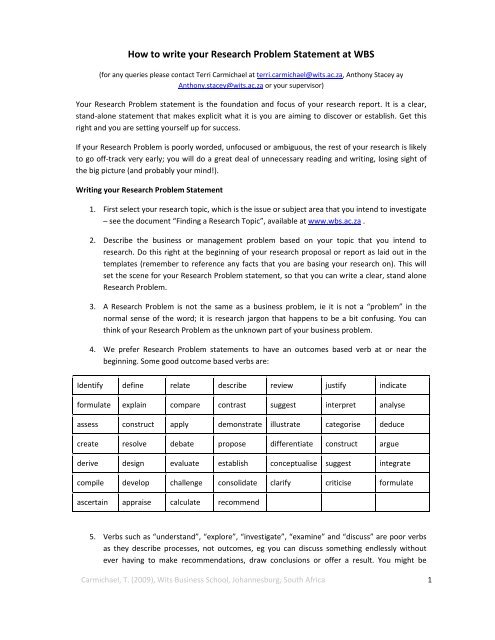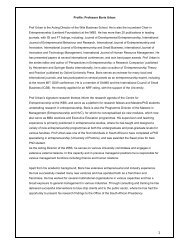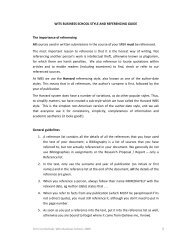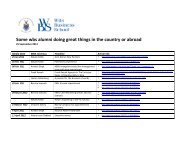How to write your Research Problem Statement at WBS
How to write your Research Problem Statement at WBS
How to write your Research Problem Statement at WBS
Create successful ePaper yourself
Turn your PDF publications into a flip-book with our unique Google optimized e-Paper software.
<strong>How</strong> <strong>to</strong> <strong>write</strong> <strong>your</strong> <strong>Research</strong> <strong>Problem</strong> <strong>St<strong>at</strong>ement</strong> <strong>at</strong> <strong>WBS</strong><br />
(for any queries please contact Terri Carmichael <strong>at</strong> terri.carmichael@wits.ac.za, Anthony Stacey ay<br />
Anthony.stacey@wits.ac.za or <strong>your</strong> supervisor)<br />
Your <strong>Research</strong> <strong>Problem</strong> st<strong>at</strong>ement is the found<strong>at</strong>ion and focus of <strong>your</strong> research report. It is a clear,<br />
stand‐alone st<strong>at</strong>ement th<strong>at</strong> makes explicit wh<strong>at</strong> it is you are aiming <strong>to</strong> discover or establish. Get this<br />
right and you are setting <strong>your</strong>self up for success.<br />
If <strong>your</strong> <strong>Research</strong> <strong>Problem</strong> is poorly worded, unfocused or ambiguous, the rest of <strong>your</strong> research is likely<br />
<strong>to</strong> go off‐track very early; you will do a gre<strong>at</strong> deal of unnecessary reading and writing, losing sight of<br />
the big picture (and probably <strong>your</strong> mind!).<br />
Writing <strong>your</strong> <strong>Research</strong> <strong>Problem</strong> <strong>St<strong>at</strong>ement</strong><br />
1. First select <strong>your</strong> research <strong>to</strong>pic, which is the issue or subject area th<strong>at</strong> you intend <strong>to</strong> investig<strong>at</strong>e<br />
– see the document “Finding a <strong>Research</strong> Topic”, available <strong>at</strong> www.wbs.ac.za .<br />
2. Describe the business or management problem based on <strong>your</strong> <strong>to</strong>pic th<strong>at</strong> you intend <strong>to</strong><br />
research. Do this right <strong>at</strong> the beginning of <strong>your</strong> research proposal or report as laid out in the<br />
templ<strong>at</strong>es (remember <strong>to</strong> reference any facts th<strong>at</strong> you are basing <strong>your</strong> research on). This will<br />
set the scene for <strong>your</strong> <strong>Research</strong> <strong>Problem</strong> st<strong>at</strong>ement, so th<strong>at</strong> you can <strong>write</strong> a clear, stand alone<br />
<strong>Research</strong> <strong>Problem</strong>.<br />
3. A <strong>Research</strong> <strong>Problem</strong> is not the same as a business problem, ie it is not a “problem” in the<br />
normal sense of the word; it is research jargon th<strong>at</strong> happens <strong>to</strong> be a bit confusing. You can<br />
think of <strong>your</strong> <strong>Research</strong> <strong>Problem</strong> as the unknown part of <strong>your</strong> business problem.<br />
4. We prefer <strong>Research</strong> <strong>Problem</strong> st<strong>at</strong>ements <strong>to</strong> have an outcomes based verb <strong>at</strong> or near the<br />
beginning. Some good outcome based verbs are:<br />
Identify define rel<strong>at</strong>e describe review justify indic<strong>at</strong>e<br />
formul<strong>at</strong>e explain compare contrast suggest interpret analyse<br />
assess construct apply demonstr<strong>at</strong>e illustr<strong>at</strong>e c<strong>at</strong>egorise deduce<br />
cre<strong>at</strong>e resolve deb<strong>at</strong>e propose differenti<strong>at</strong>e construct argue<br />
derive design evalu<strong>at</strong>e establish conceptualise suggest integr<strong>at</strong>e<br />
compile develop challenge consolid<strong>at</strong>e clarify criticise formul<strong>at</strong>e<br />
ascertain appraise calcul<strong>at</strong>e recommend<br />
5. Verbs such as “understand”, “explore”, “investig<strong>at</strong>e”, “examine” and “discuss” are poor verbs<br />
as they describe processes, not outcomes, eg you can discuss something endlessly without<br />
ever having <strong>to</strong> make recommend<strong>at</strong>ions, draw conclusions or offer a result. You might be<br />
Carmichael, T. (2009), Wits Business School, Johannesburg, South Africa 1
exploring, examining or discussing as part of <strong>your</strong> process, but they cannot be the end result of<br />
<strong>your</strong> research, which should be more tangible.<br />
6. If <strong>your</strong> <strong>Research</strong> <strong>Problem</strong> contains two or more concepts / ideas, then break it down in<strong>to</strong> sub‐<br />
problems, so th<strong>at</strong> each sub‐problem consists of one idea only. Each sub‐problem should<br />
contain key words th<strong>at</strong> you can use in <strong>your</strong> liter<strong>at</strong>ure search (using the electronic library<br />
d<strong>at</strong>abases and Google Scholar) on th<strong>at</strong> sub‐problem.<br />
7. Your <strong>Research</strong> <strong>Problem</strong> st<strong>at</strong>ement should be <strong>your</strong> sub‐problems added <strong>to</strong>gether – no more<br />
and no less. Do not introduce any new ideas when you <strong>write</strong> <strong>your</strong> sub‐problems. For example:<br />
The Main problem is <strong>to</strong><br />
Sub‐problem 1<br />
Sub‐problem 2<br />
Analyse and evalu<strong>at</strong>e the role of entrepreneurship in the establishment of small,<br />
medium and micro enterprises (SMMEs) and ascertain the value of the economic<br />
contributions of these firms in emerging markets.<br />
Analyse and evalu<strong>at</strong>e the role of entrepreneurship in establishing SMMEs in emerging<br />
markets. (Here <strong>your</strong> key search terms for <strong>your</strong> liter<strong>at</strong>ure review could be<br />
“entrepreneurship”, “SMME” and “emerging markets”)<br />
Evalu<strong>at</strong>e the economic contribution of SMMEs <strong>to</strong> growth and development in<br />
emerging markets. (Here <strong>your</strong> search terms could be “economic contribution”,<br />
“economic growth”, “emerging market development”)<br />
Your liter<strong>at</strong>ure review would be likely <strong>to</strong> have headings similar or rel<strong>at</strong>ed <strong>to</strong> the search terms,<br />
as well as other <strong>to</strong>pic areas th<strong>at</strong> you find and are relevant but th<strong>at</strong> you may not have<br />
anticip<strong>at</strong>ed – in fact you will find a lot of inform<strong>at</strong>ion and rel<strong>at</strong>ed <strong>to</strong>pics th<strong>at</strong> you won’t (and<br />
cannot be expected <strong>to</strong>) have anticip<strong>at</strong>ed. Use the search terms both alone and combined with<br />
each other.<br />
You won’t find many articles on exactly <strong>your</strong> own research problem (th<strong>at</strong>’s why you are<br />
researching it), so <strong>your</strong> liter<strong>at</strong>ure review will be on <strong>to</strong>pics broader than, but encompassing <strong>your</strong><br />
specific problem. More detail can be found in the document “<strong>How</strong> <strong>to</strong> do a Liter<strong>at</strong>ure Review”<br />
on www.wbs.ac.za.<br />
Another example, starting with the research context and <strong>to</strong>pic:<br />
<strong>Research</strong> <strong>to</strong>pic and context (st<strong>at</strong>ed exactly as submitted by a student):<br />
The large corpor<strong>at</strong>e companies need <strong>to</strong> be encouraged <strong>to</strong> assist small businesses in<br />
empowering them with the necessary skills and resources <strong>to</strong> grow. Corpor<strong>at</strong>e Social<br />
Responsibility is one avenue th<strong>at</strong> small business can benefit from big business in this<br />
regard. My aim in this research is <strong>to</strong> establish if large companies are using corpor<strong>at</strong>e<br />
social responsibility <strong>to</strong> empower small business and, if not, how this can be done.<br />
Carmichael, T. (2009), Wits Business School, Johannesburg, South Africa 2
Therefore the <strong>to</strong>pic of this research is <strong>to</strong> identify the role of corpor<strong>at</strong>e social<br />
responsibility in empowering small business.<br />
The <strong>Problem</strong> <strong>St<strong>at</strong>ement</strong> was constructed by tightening up the context <strong>to</strong> elimin<strong>at</strong>e repetition,<br />
correcting the grammar, removing the personal pronoun “my” and rephrasing it in the passive<br />
voice. In addition, the st<strong>at</strong>ement “. . . establish IF large companies . . .” was rephrased <strong>to</strong><br />
“whether and how” because “if” has a yes / no answer (not OK) and “whether and how”<br />
requires a detailed, contextualised and rich response (OK).<br />
<strong>Problem</strong> st<strong>at</strong>ement:<br />
The intention of this research is <strong>to</strong> establish the purposes for which large corpor<strong>at</strong>e are<br />
using their CSI / CSR programmes, with particular reference <strong>to</strong> whether and how they are<br />
using such programmes <strong>to</strong> empower small businesses, and, further, <strong>to</strong> g<strong>at</strong>her ideas <strong>to</strong><br />
expand such investments.<br />
Sub‐problem 1:<br />
Establish the purposes for which large corpor<strong>at</strong>es are using their CSI / CSR programmes<br />
Sub‐problem 2<br />
Identify ways in which large corpor<strong>at</strong>es are using CSI / CSR programmes <strong>to</strong> empower small<br />
businesses, and further, <strong>to</strong> g<strong>at</strong>her ideas for expanding such investments<br />
8. Your sub‐problems should NOT be steps in the process of finding the solution <strong>to</strong> <strong>your</strong> <strong>Research</strong><br />
<strong>Problem</strong>. This is a common and understandable error. The example below shows the sub‐<br />
problems <strong>to</strong> be steps in the process th<strong>at</strong> the student intends <strong>to</strong> follow in the research (these<br />
can be described in the methodology chapter). They are not invalid ‐ they are just not sub‐<br />
problems.<br />
Main <strong>Problem</strong><br />
Compare the characteristics of the South African and Ghanaian home loan markets in<br />
rel<strong>at</strong>ion <strong>to</strong> consumer home loan choice criteria, home finance availability on both markets,<br />
home loan administr<strong>at</strong>ion, success and hindering fac<strong>to</strong>rs, risks in pricing of home finance,<br />
the st<strong>at</strong>us and causes of home loan default in both markets and <strong>to</strong> predict the way forward<br />
for both markets.<br />
Sub‐problems<br />
1. Analyse consumer choice criteria in both home loans markets<br />
2. Assess the availability and accessibility of home loans.<br />
3. Establish the difficulties encountered in home loan administr<strong>at</strong>ion<br />
4. Identify the risks in home loan pricing and the effect of infl<strong>at</strong>ion on pricing<br />
5. Determine the st<strong>at</strong>us and causes of home loan default<br />
6. Forecast the future of the South African and Ghanaian home loan markets<br />
Carmichael, T. (2009), Wits Business School, Johannesburg, South Africa 3
In the example, the “sub‐problems” listed are certainly useful <strong>to</strong>pics <strong>to</strong> include in the liter<strong>at</strong>ure<br />
review, although the list may not be exhaustive ‐ keep an open mind <strong>to</strong> finding other fac<strong>to</strong>rs in the<br />
liter<strong>at</strong>ure th<strong>at</strong> you may not have thought about. The liter<strong>at</strong>ure review is a process of discovery,<br />
and you don’t know wh<strong>at</strong>’s been published until you get there.<br />
A possible altern<strong>at</strong>ive <strong>to</strong> the above could be:<br />
Main <strong>Problem</strong>:<br />
Compare the actual and perceived characteristics of the South African and Ghanaian home<br />
loan markets and determine the n<strong>at</strong>ure of any rel<strong>at</strong>ionship between these characteristics and<br />
payment defaults. Identify any other causes of home loan defaults in these markets and<br />
possible measures <strong>to</strong> reduce them.<br />
Sub‐problem 1<br />
Identify the actual and perceived characteristics of the South African and Ghanaian home loan<br />
markets.<br />
Sub‐problem 2<br />
Determine the causes of home loan defaults, whether they are rel<strong>at</strong>ed or not <strong>to</strong> the home loan<br />
market characteristics and seek measures <strong>to</strong> reduce the occurrence of such defaults.<br />
9. Your problem and sub‐problems should not have a yes / no answer or solution.<br />
10. Your problem and sub‐problems should not suggest the solution / finding th<strong>at</strong> you expect,<br />
otherwise you are introducing bias.<br />
11. Not all problems have sub‐problems; if <strong>your</strong> problem st<strong>at</strong>ement contains only one concept or<br />
idea, and cannot be broken down in<strong>to</strong> smaller concepts, you will have only a problem<br />
st<strong>at</strong>ement with no sub‐problems.<br />
12. A sub‐problem should not depend on a particular answer <strong>to</strong> a previous sub‐problem – you will<br />
be in trouble if it does not work out the way you anticip<strong>at</strong>ed. To avoid this, make sure th<strong>at</strong><br />
each sub‐problem can stand alone, ie it could be a small research project by itself, such as in<br />
the example in point 8 of this document.<br />
13. You should only have a small number of sub‐problems – no more than 2 <strong>to</strong> 3 preferably. If you<br />
have <strong>to</strong>o many, <strong>your</strong> project may be <strong>to</strong>o big. In this case, exclude some of the investig<strong>at</strong>ion<br />
and st<strong>at</strong>e wh<strong>at</strong> you will NOT be including in <strong>your</strong> research under the heading “Delimit<strong>at</strong>ions”.<br />
14. Your sub‐problems with their key words are <strong>your</strong> guide as <strong>to</strong> wh<strong>at</strong> <strong>to</strong> look up in the liter<strong>at</strong>ure<br />
<strong>to</strong> see wh<strong>at</strong> has already been published on <strong>your</strong> <strong>to</strong>pic. Your liter<strong>at</strong>ure review is based on one<br />
sub‐problem <strong>at</strong> a time. Thus <strong>your</strong> sub‐problems will keep you on track – but they may be<br />
tweaked from time <strong>to</strong> time as you read more and more – it is an iter<strong>at</strong>ive process.<br />
Prepare <strong>to</strong> do a LOT of reading around <strong>your</strong> <strong>to</strong>pic.<br />
To be a “Master” of <strong>your</strong> <strong>to</strong>pic, you need <strong>to</strong> know most of wh<strong>at</strong> has been<br />
Carmichael, written T. (2009), about Wits it, Business wh<strong>at</strong> the School, main ideas Johannesburg, are, who the South most Africa important authors<br />
4<br />
are, and be able <strong>to</strong> differenti<strong>at</strong>e credible sources from those th<strong>at</strong> are not.













